

Molecular polymorphism related to flowering trait variation in a Phaseolus vulgaris L. collection. Highlights Common bean European accessions were characterized by flowering precocity.
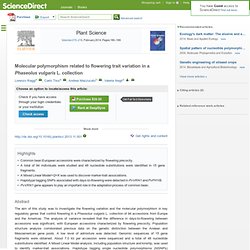
A total of 94 individuals were studied and 48 nucleotide substitutions were identified in 15 gene fragments. A Mixed Linear Model+Q+K was used to discover marker-trait associations. Haplotype tagging SNPs associated with days-to-flowering were detected in PvVRN1 and PvPHYB. PvVRN1 gene appears to play an important role in the adaptation process of common bean. Abstract The aim of this study was to investigate the flowering variation and the molecular polymorphism in key regulatory genes that control flowering in a Phaseolus vulgaris L. collection of 94 accessions from Europe and the Americas.
Abbreviations Keywords Phaseolus vulgaris L.; Flowering time; Marker-trait association; Candidate genes; VRN1 gene Copyright © 2013 Elsevier Ireland Ltd. Clonal diversity and estimation of relative clone age: application to agrobiodiversity of yam (Dioscorea rotundata) Research article Nora Scarcelli1*, Marie Couderc1, Mohamed N Baco2, Janvier Egah2 and Yves Vigouroux1 * Corresponding author: Nora Scarcelli nora.scarcelli@ird.fr Author Affiliations 1 UMR DIADE, Team DYNADIV, Institut de Recherche pour le Développement (IRD), 911 Avenue Agropolis, BP 64501, 34394 Montpellier Cedex 5, France 2 Faculté d’Agronomie, Université de Parakou, BP 123 Parakou, Bénin For all author emails, please log on.
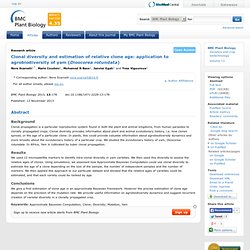
BMC Plant Biology 2013, 13:178 doi:10.1186/1471-2229-13-178 Published: 13 November 2013 Abstract Background Clonal propagation is a particular reproductive system found in both the plant and animal kingdoms, from human parasites to clonally propagated crops. Results We used 12 microsatellite markers to identify intra-clonal diversity in yam varieties. Conclusions We give a first estimation of clone age in an approximate Bayesian framework. Keywords: Approximate Bayesian Computation; Clone; Diversity; Mutation; Yam close. Genetic recombination is associated with intrinsic disorder in plant proteomes. A comprehensive meta QTL analysis for fiber quality, yield, yield related and morphological traits, drought tolerance, and disease resistance in tetraploid cotton.
Research article Joseph I Said1, Zhongxu Lin2, Xianlong Zhang2, Mingzhou Song3 and Jinfa Zhang1* * Corresponding author: Jinfa Zhang jinzhang@nmsu.edu.
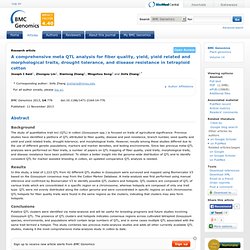
Comparative genomics reveals candidate carotenoid pathway regulators of ripening watermelon fruit. Research article Stefania Grassi12, Gabriella Piro1, Je Min Lee2, Yi Zheng2, Zhangjun Fei2, Giuseppe Dalessandro1, James J Giovannoni2 and Marcello S Lenucci1* * Corresponding author: Marcello S Lenucci marcello.lenucci@unisalento.it Author Affiliations 1 Dipartimento di Scienze e Tecnologie Biologiche ed Ambientali (Di.S.Te.B.A.), Università del Salento, via Prov.le Lecce-Monteroni,73100 Lecce, Italy.
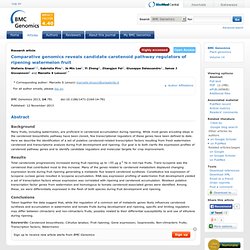
High presence/absence gene variability in defense-related gene clusters of Cucumis melo. Research article Víctor M González1, Núria Aventín1, Emilio Centeno2 and Pere Puigdomènech1* * Corresponding author: Pere Puigdomènech pere.puigdomenech@cragenomica.es Author Affiliations 1 Molecular Genetics Department, Center for Research in Agricultural Genomics CRAG (CSIC-IRTA-UAB-UB), Campus UAB, Edifici CRAG, Bellaterra (Cerdanyola del Vallès), 08193 Barcelona, Spain 2 Bioinformatics Core Unit, Center for Research in Agricultural Genomics CRAG (CSIC-IRTA-UAB-UB), Campus UAB, Edifici CRAG, Bellaterra (Cerdanyola del Vallès), 08193 Barcelona, Spain For all author emails, please log on.
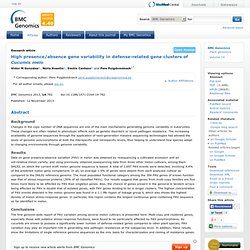
BMC Genomics 2013, 14:782 doi:10.1186/1471-2164-14-782 Published: 12 November 2013 Abstract Background Changes in the copy number of DNA sequences are one of the main mechanisms generating genome variability in eukaryotes. Results Conclusions The first genome-wide report of PAV variation among several melon cultivars is presented here. Close Sign up to receive new article alerts from BMC Genomics.
Genomics Assisted Ancestry Deconvolution in Grape. The genus Vitis (the grapevine) is a group of highly diverse, diploid woody perennial vines consisting of approximately 60 species from across the northern hemisphere.
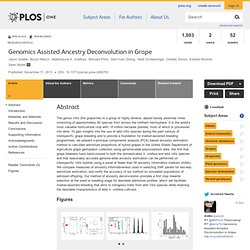
It is the world’s most valuable horticultural crop with ~8 million hectares planted, most of which is processed into wine. To gain insights into the use of wild Vitis species during the past century of interspecific grape breeding and to provide a foundation for marker-assisted breeding programmes, we present a principal components analysis (PCA) based ancestry estimation method to calculate admixture proportions of hybrid grapes in the United States Department of Agriculture grape germplasm collection using genome-wide polymorphism data. We find that grape breeders have backcrossed to both the domesticated V. vinifera and wild Vitis species and that reasonably accurate genome-wide ancestry estimation can be performed on interspecific Vitis hybrids using a panel of fewer than 50 ancestry informative markers (AIMs).